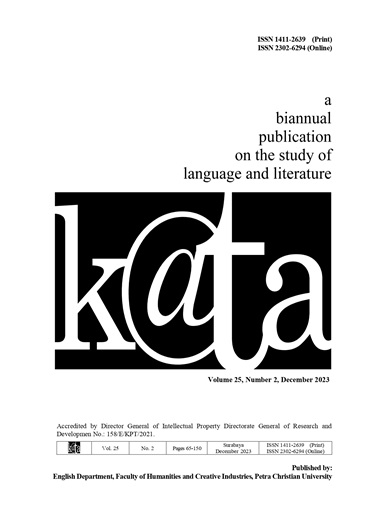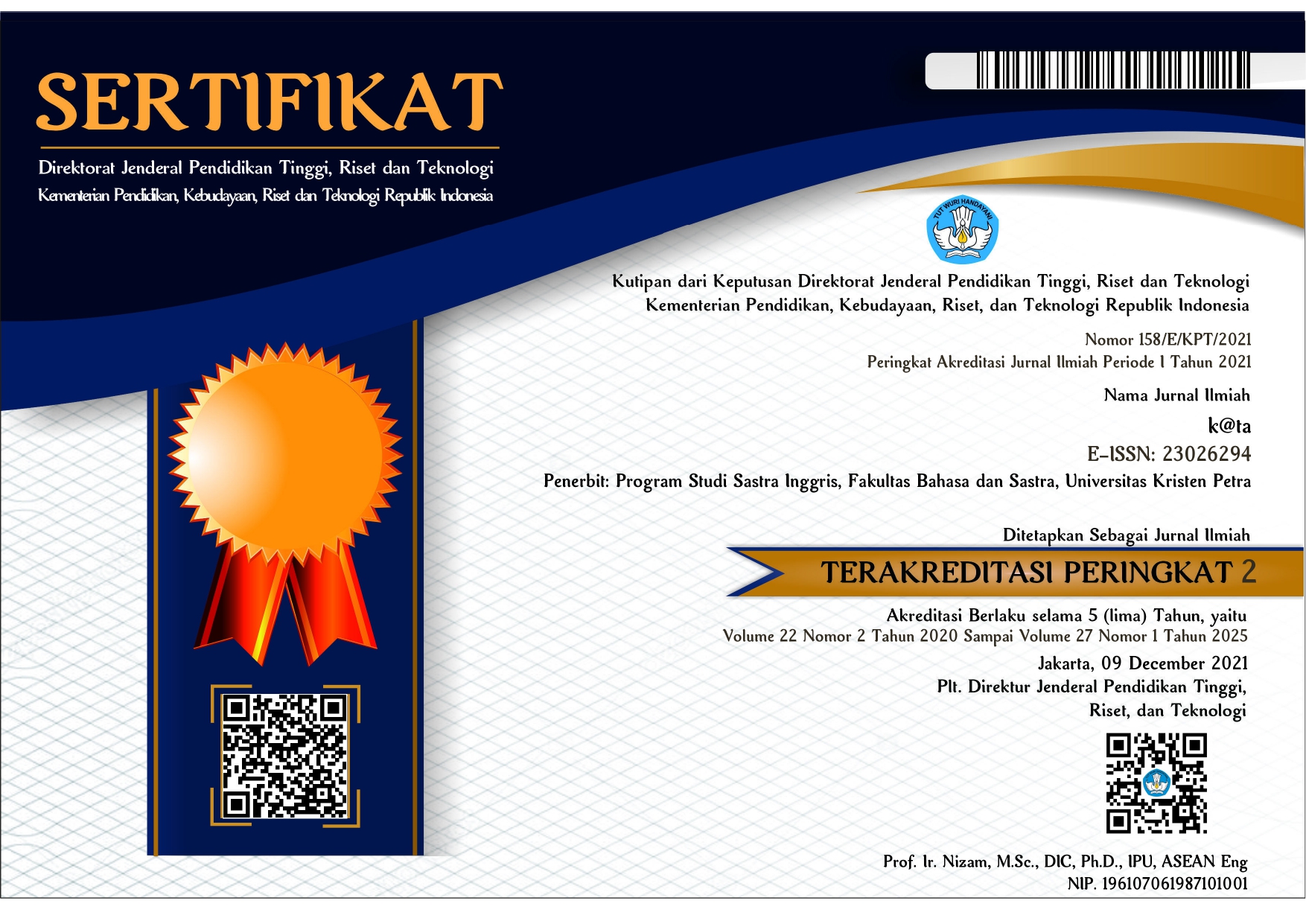Red Badge of Courage and Jalan Tak Ada Ujung: Comparing Indonesia’s and America’s National Masculinity
Abstract
Masculinity linked to conflict or war is often seen as hegemonic. This research offers two literary texts from two different countries: Stephen Crane’s The Red Badge of Courage (2005) and Muchtar Lubis’ Jalan Tak Ada Ujung (The Endless Road) (1952). By comparing and contrasting both countries in terms of non-hegemonic masculinities of the protagonist characters, the pattern of masculinities of each nation, which is often overlooked, can be explainable. We can identify variations of masculinities in classic fiction, which reflect the national discourses. By utilizing the notion of focalization, the method of narratology can locate the power relation and agency in the story. Post-war anxiety as well as the ideology of fatherism and momism constructs the national gendered discoures. Indonesia’s masculinity resists the legitimate and privileged as well as the status-quo concept of national masculinity. The resistance implies that Indonesia’s national masculinity is more diverse and progressive than America’s is.
Downloads
References
Bassnett, S. (1993). Comparative literature: A critical introduction. Oxford: Blackwell Publishers.
Beasley, C. (2008). Rethinking hegemonic masculinity in a globalizing world. Men and Masculinities, 11(1), 86-103. https://doi.org/10.1177/1097184X08315102
Clark, M. (2004). Men, masculinities, and symbolic violence in recent Indonesian cinema. Journal of Southeast Asian Studies, 35(1), 113-131. https://doi.org/10.1017/S0022463404000062
Connell. R. W. (1995). Masculinities.. Berkeley: University of California Press.
Connell, R. W. and Messerschmidt, J.W. (2005). Hegemonic masculinity: Rethinking the concept. Gender and Society, 19(6), 829-859. https://doi.org/10.1177/0891243205278639
Coontz, S. (2011, May 7). When we hated mom. The New York Times. https://www.nytimes.com/2011/05/08/opinion/08 coontz.html
Crane,.S. (2005). The red badge of courage and other stories. London: Penguin.
de Lauretis, T. (2008). Freud’s drive: Psychoanalysis, literature, and film. New York: Palgrave Macmillan.
Demetriou, D. Z. (2001). Connell’s concept of hegemonic masculinity: A critique. Theory and Society, 30, 337-361. https://doi.org/10.1023/A:1017596718715
Duncanson, C. (2020). Masculinities, war, and militarism. In L. Gottzzén, U. Mellström, & T. Shefer (Eds), Routledge international handbook of masculinity studies (pp. 467-476). New York: Routledge.
Fischer, L. (2002). Mama’s boy: Filial hysteria in White Heat. In S. Cohan & I. R. Hark (Eds), Screening the male: Exploring masculinities in Hollywood cinema (pp. 70-84). New York: Routledge.
Johnson, E. A. (1992). She who is: The mystery of God in feminist theological discourse. New York: Crossroad.
Kimmel, M. S. (2005). Globalization and its mal(e)contents: The gendered moral and political economy of terrorism. In M. S. Kimmel, J. Hearn, & R. W. Connell (Eds), Handbook studies on men & masculinities (pp. 414-430). Thousand Oaks: Sage.
Kroker, A., & Kroker, M. (Eds). (1991). The histerical male: New feminist theory. New York: St. Martin Press.
Kuipers, J. C., & Askuri. (2017). Islamization and identity in Indonesia: The case of Arabic names in Java. Indonesia, 25-49. https://doi.org/10.1353/ind.2017.0001
Lubis, M. (1952). Jalan tak ada ujung [The endless road]. Jakarta: Yayasan Pustaka Obor.
McClintock, A. (1995). Imperial leather: Race, gender, and sexuality in the colonial context. London: Routledge.
Micale, M. S. (2008). Hysterical men: The hidden history of male nervous illness. Cambridge, MA: Harvard University Press.
Mitchel, J. (2000). Mad men and medusas: Reclaiming hysteria. New York: Basic Books.
Morrell, R. & Swart, S. (2005). Men in the Third World: Postcolonial perspectives on masculinity. In M. S. Kimmel, J. Hearn, & R. W. Connell (Eds), Handbook studies on men & masculinities (pp. 90-113). Thousand Oaks: Sage.
Paramaditha, I. (2007). Contesting Indonesian nationalism and masculinity in cinema. Asian Cinema Studies Society, 18(2), 41-61. https://doi.org/10.1386/ac.18.2.41_1
Ruether, R. R. (1983). Sexism and God-talk: Toward a feminist theology. London: SCM.
Rycroft, C. (1995). A critical dictionary of psychoanalysis. New York: Penguin.
Said, E. W. (1996). Representation of the intellectual. New York: Vintage.
Scull, A. (2011). Hysteria: The disturbing history. New York: Oxford University Press.
Steven, J. R., (2015). Captain America, masculinity, and violence. New York: Syracuse University Press
Van den Oever, Roel. (2012). Mama’s boy and the homophobia in Post-war American culture. New York: Palgrave Macmillan.
Wylie, P. (1955). Generation of Vipers (20th Ed.). Toronto: Clarke, Irwin & Company. (Original work published 1942).

This work is licensed under a Creative Commons Attribution 4.0 International License.
![]() This work is licensed under a Creative Commons Attribution License
This work is licensed under a Creative Commons Attribution License




.png)
.png)

.png)













